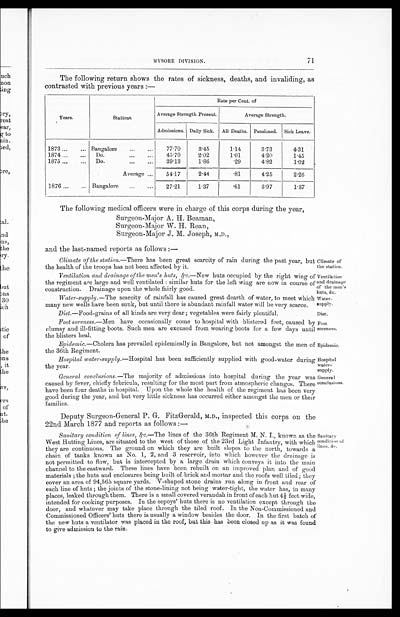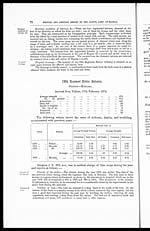Medicine - Institutions > Army health reports and medical documents > Medical and sanitary reports of the native army of Madras > Medical and sanitary report of the native army of Madras for the year 1876
(80) Page 71
Download files
Individual page:
Thumbnail gallery: Grid view | List view

MYSORE DIVISION.
71
The following return shows the rates of sickness, deaths, and invaliding, as
contrasted with previous years:—
| Years. | Stations. | Rate per Cent. of | ||||
| Average Strength Present. | Average Strength. | |||||
| Admissions. | Daily Sick. | All Deaths. | Pensioned. | Sick Leave. | ||
| 1873 | Bangalore | 77.70 | 3.45 | 1.14 | 3.73 | 4.31 |
| 1874 | Do. | 45.70 | 2.02 | 1.01 | 4.20 | 1.45 |
| 1875 | Do. | 39.13 | 1.86 | .29 | 4.82 | 1.02 |
| Average | 54.17 | 2.44 | .81 | 4.25 | 2.26 | |
| 1876 | Bangalore | 27.21 | 1.37 | .61 | 3.97 | 1.37 |
The following medical officers were in charge of this corps during the year,
Surgeon-Major A. H. Beaman,
Surgeon-Major W. H. Rean,
Surgeon-Major J. M. Joseph, M.D.,
and the last-named reports as follows:—
Climate of
the station.
Climate of the station .—There has been great scarcity of rain during the past year, but
the health of the troops has not been affected by it.
Ventilation
and drainage
of the men's
huts, &c.
Ventilation and drainage of the men's huts,&c. —New huts occupied by the right wing of
the regiment are large and well ventilated: similar huts for the left wing are now in course of
construction. Drainage upon the whole fairly good.
Water-
supply.
Water-supply. —The scarcity of rainfall has caused great dearth of water, to meet which
many new wells have been sunk, but until there is abundant rainfall water will be very scarce.
Diet.
Diet. —Food-grains of all kinds are very dear; vegetables were fairly plentiful.
Foot
soreness
Foot soreness. —Men have occasionally come to hospital with blistered feet, caused by
clumsy and ill-fitting boots. Such men are excused from wearing boots for a few days until
the blisters heal.
Epidemic.
Epidemic. —Cholera has prevailed epidemically in Bangalore, but not amongst the men of
the 36th Regiment.
water-
supply.
Hospital water-supply .—Hospital has been sufficiently supplied with good-water during
the year.
GeneraI
conclusions
General conclusions. —The majority of admissions into hospital during the year was
caused by fever, chiefly febricula, resulting for the most part from atmospheric changes. There
have been four deaths in hospital. Upon the whole the health of the regiment has been very
good during the year, and but very little sickness has occurred either amongst the men or their
families.
Deputy Surgeon-General P. G. FitzGerald, M.D., inspected this corps on the
22nd March 1877 and reports as follows:—
Sanitary
condition of
lines, &c.
Sanitary condition of lines, &c. —The lines of the 36th Regiment M. N. I., known as the
West Hutting Lines, are situated to the west of those of the 23rd Light Infantry, with which
they are continuous. The ground on which they are built slopes to the north, towards a
chain of tanks known as No. 1, 2, and 3 reservoir, into which however the drainage is
not permitted to flow, but is intercepted by a large drain which conveys it into the main.
channel to the eastward. These lines have been rebuilt on an improved plan and of good
materials; the huts and enclosures being built of brick and mortar and the roofs well tiled; they
cover an area of 94,565 square yards. V-shaped stone drains run along in front and rear of
each line of huts; the joints of the stone-lining not being water-tight, the water has, in many
places, leaked through them. There is a small covered verandah in front of each hut 4½ feet wide,
intended for cooking purposes. In the sepoys' huts there is no ventilation except through the
door, and whatever may take place through the tiled roof. In the Non-Commissioned and
Commissioned Officers' huts there is usually a window besides the door. In the first batch of
the new huts a ventilator was placed in the roof, but this has been closed up as it was found
to give admission to the rain.
Set display mode to: Large image | Zoom image | Transcription
Images and transcriptions on this page, including medium image downloads, may be used under the Creative Commons Attribution 4.0 International Licence unless otherwise stated. ![]()
| Permanent URL | https://digital.nls.uk/74991544 |
|---|




